Cut off from the world and saved from Muslim invaders by their location in three remote mountain valleys, the Kalash people are a cultural world apart from the predominantly Muslim population of Pakistan. The colorful Kalash people are animists, not Muslims, make their own wine, and have a plethora of other unique traditions and festivals.
Below you can find a guide to the Kalasha Valleys, including information on Kalasha culture, which of the Kalash Valleys to visit, how to get to the valleys from Chitral, and much more about visiting the valley and spending time with the Kalash people.
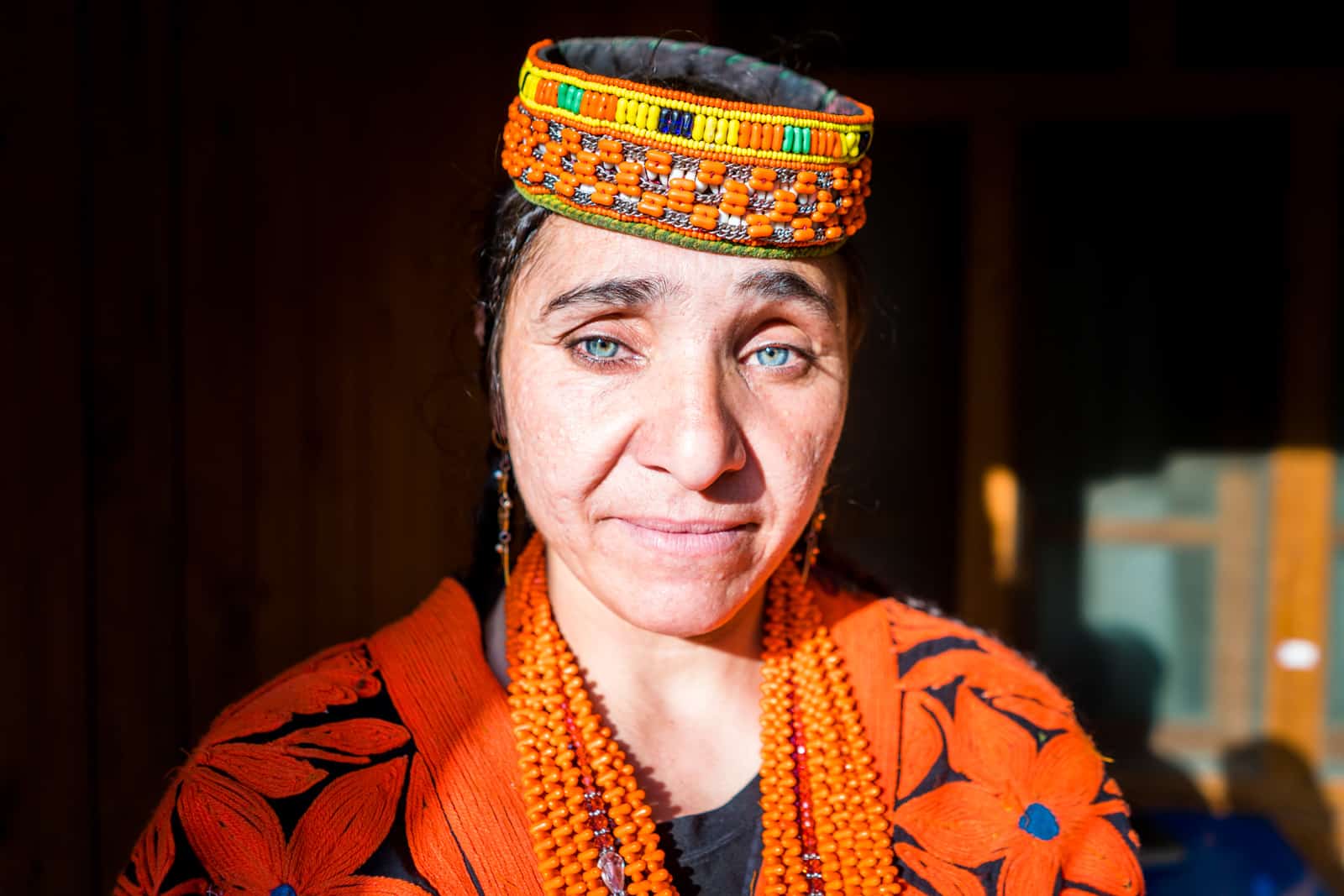
Blue eyes like this are common throughout the Kalash Valleys
Which Kalash Valley to visit
Before you go, you must decide which of the three Kalasha Valleys you want to visit:
- Bumburet – The most developed valley in terms of facilities, and most popular with domestic tourists.
- Rumboor – Small villages in Rumboor are less developed and more popular with foreign tourists. Unlike Bumburet, Rumboor is still predominantly Kalash.
- Birir – The least developed Kalasha Valley, and sees the least visitors.
I suggest you visit either Rumboor or Birir, as Bumburet has undergone a Disneyfication process, and is less Kalash and more Murree at this point. The percentage of the population that is Kalasha is also much lower in Bumburet.
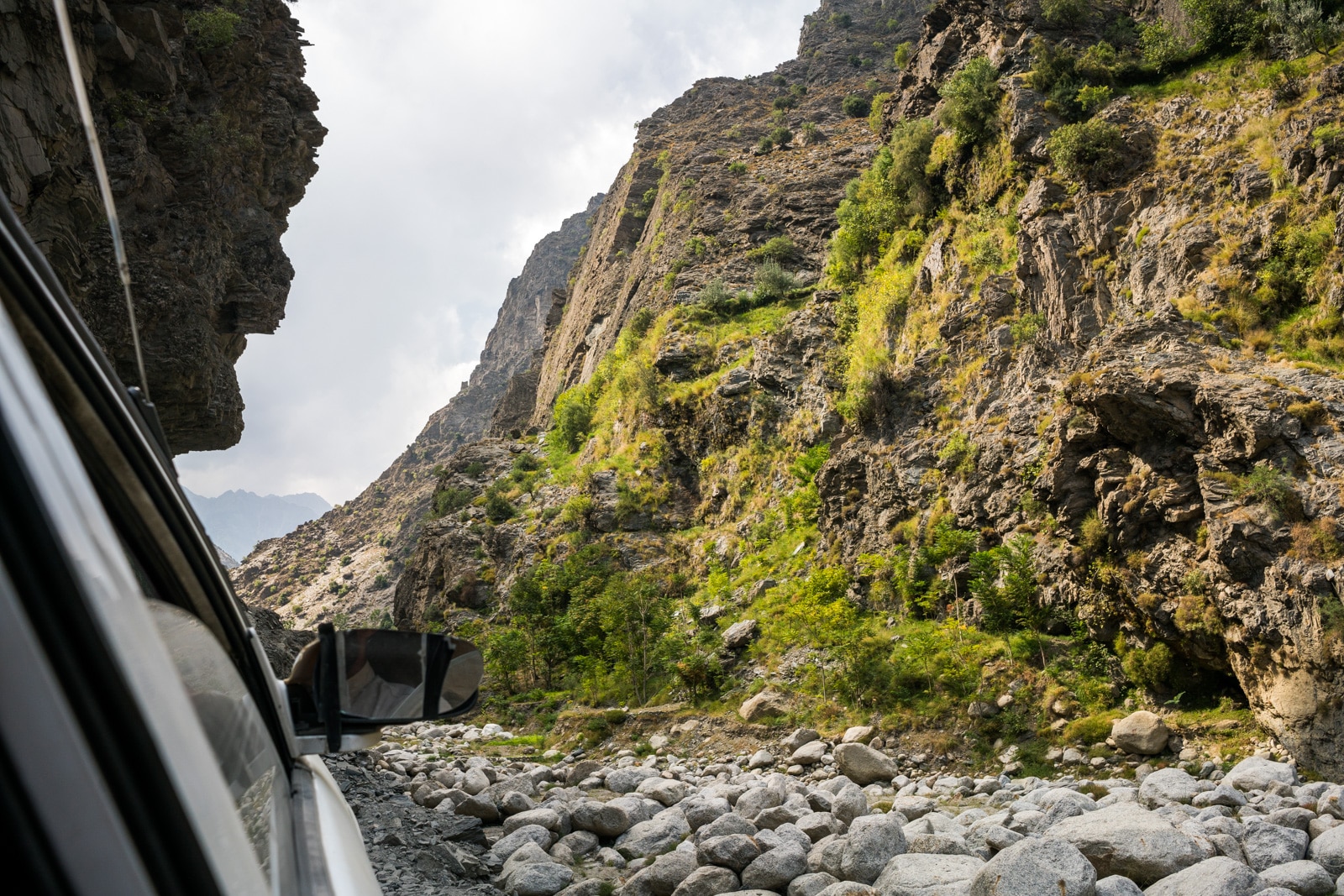
The road into the Kalash Valleys
Kalash culture
As stated above, the Kalash people are not Muslim. Their unique culture and traditions predate Islam by some years, and the Kalash people can best be described as animist, although some scholars believe their religion can be linked to ancient Hinduism.
Unfortunately, their unique culture is diminishing. Many non-Kalash have started living in the valleys. Roughly 50% of Kalash people have converted to Islam for a variety of reasons, usually related to financial struggles, marital obstacles, and societal pressures.
I spoke to several young Kalash girls who had one friend whose parents recently converted to Islam (automatically making their daughter Muslim, too). The girls were still friends, but the parents weren’t happy with this; many Muslims don’t agree with local culture and traditions.
Luckily, many of the Kalash people work to keep their culture alive. Kalasha women still wear their traditional dress, and there are many Kalash festivals celebrating and showcasing Kalasha culture. If you plan on visiting one of these festivals, make sure to read about responsible tourism in the Kalasha Valleys below.
How to get from Chitral to the valleys
Chitral is the starting point for getting to the Kalasha Valleys. Regardless of which valley you want to visit, the way of getting there by public transport is generally the same.
Direct Jeeps from Chitral to the three different valleys leave around 13:00 from near Bank Alfalah in the center of Chitral. These Jeeps charge 200 – 300 Rs per person. However, Jeeps go to Birir only when there is demand.
If you don’t want to travel during the middle of the day, there are shared cars going to the valleys in the early morning and late afternoon. To find a shared car, head to the Chitral central bus stand (the partially covered area with minibusses and shared cars), and get a shared car to Ayun. Ayun is about an hour from Chitral, and a seat costs 100 Rs or 600 Rs for the whole car.
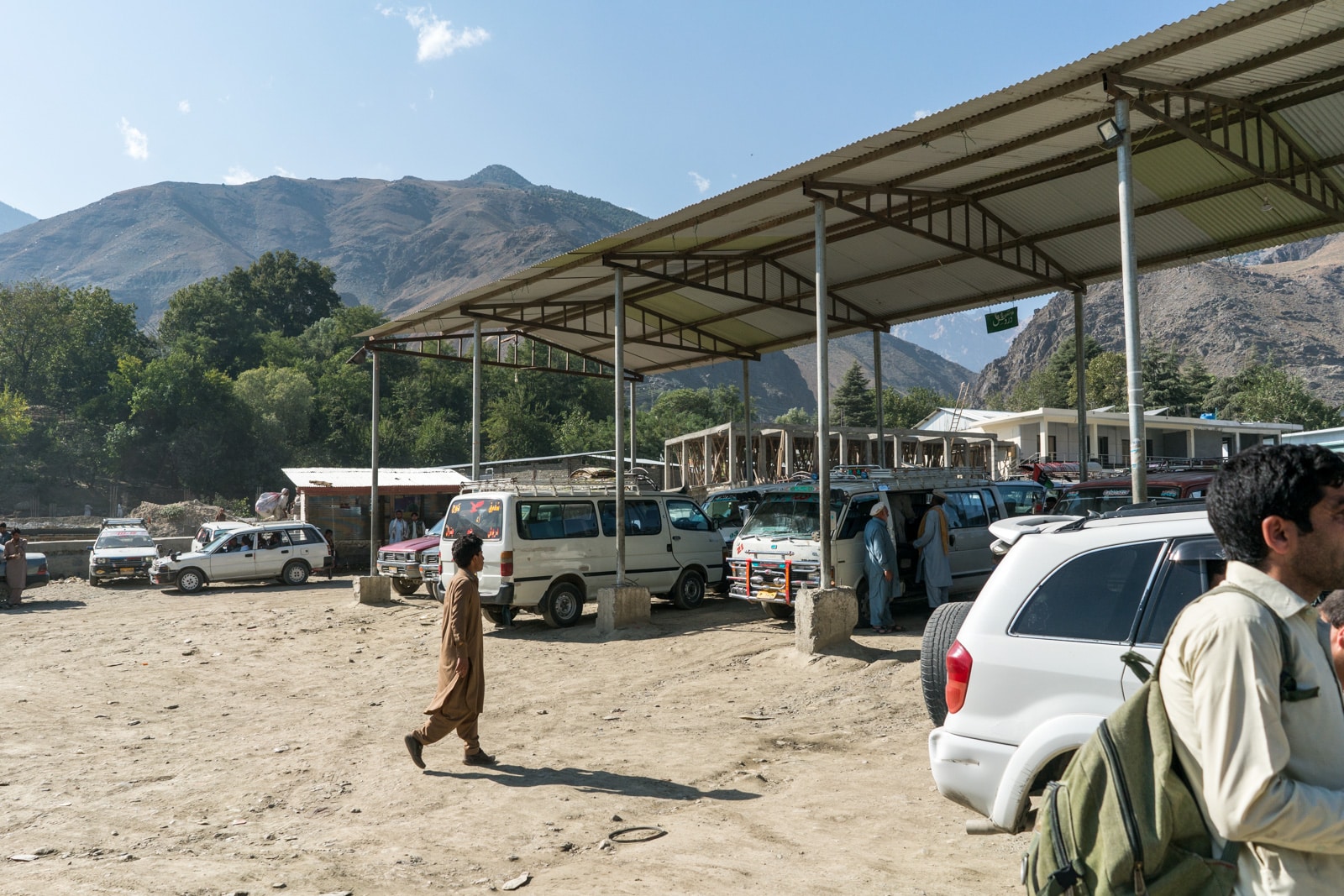
The central bus stand. Cars to Ayun can be spotted in the back on the left side, sitting close to the road.
From Ayun, shared cars and Jeeps go to the different valleys once full. They charge 100 Rs per personfor the bumpy ride to your valley of choice, although cars might charge a bit more depending on the day’s demand (or lack thereof).
If there are no transport options available when you arrive Ayun, a private hire should cost no more than 1000 – 1200 Rs to any of the valleys. However, if you wait for a while, it’s usually possible to fill up a car with other travelers and locals who are going to the valleys. From Ayun, it will take one to two hours to any of the valleys.
As of 2019, to enter the Kalash Valleys, foreigners have to pay 600 Rs per person “for the welfare of the Kalash people”.
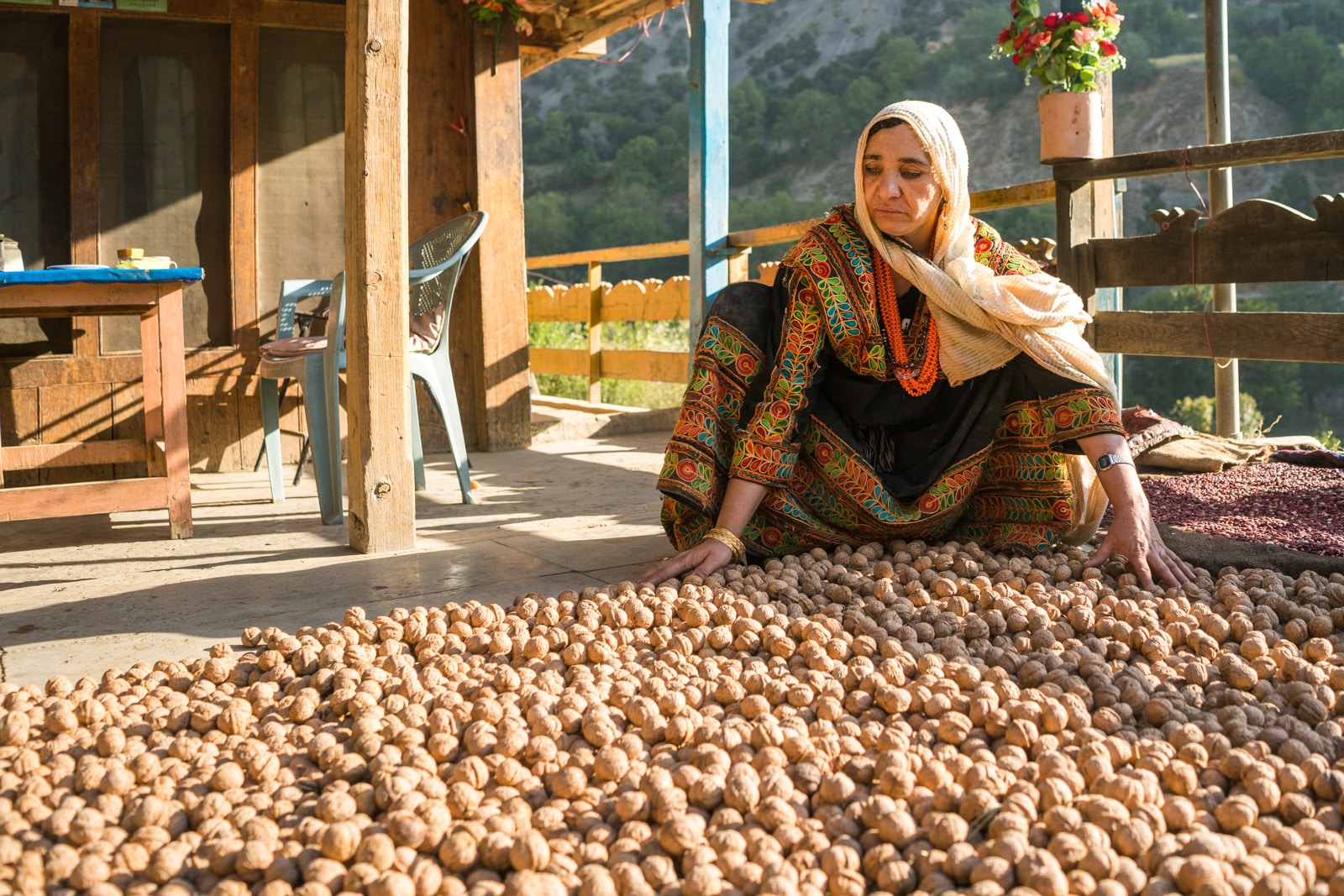
Drying out homegrown walnuts to store for winter
What to do in the Kalasha Valleys
If you’re visiting the Kalash Valley during one of the festivals, there will be plenty of feasts for the eyes. Dance, drink and be amazed at the colorful rituals and clothes on display. The festival times in Kalash Valley are:
- Chilam Joshi – May
- Uchau – Autumn, usually September
- Choimus – Two weeks around the winter solstice
However, if you visit outside of festival time, there’s not that much in the way of official things to do. The valleys are a place to sit and enjoy a bit of nature, and while away the hours chatting to and hanging out with the local people. Aim to learn a bit about their culture, not check sights off of a bucket list.
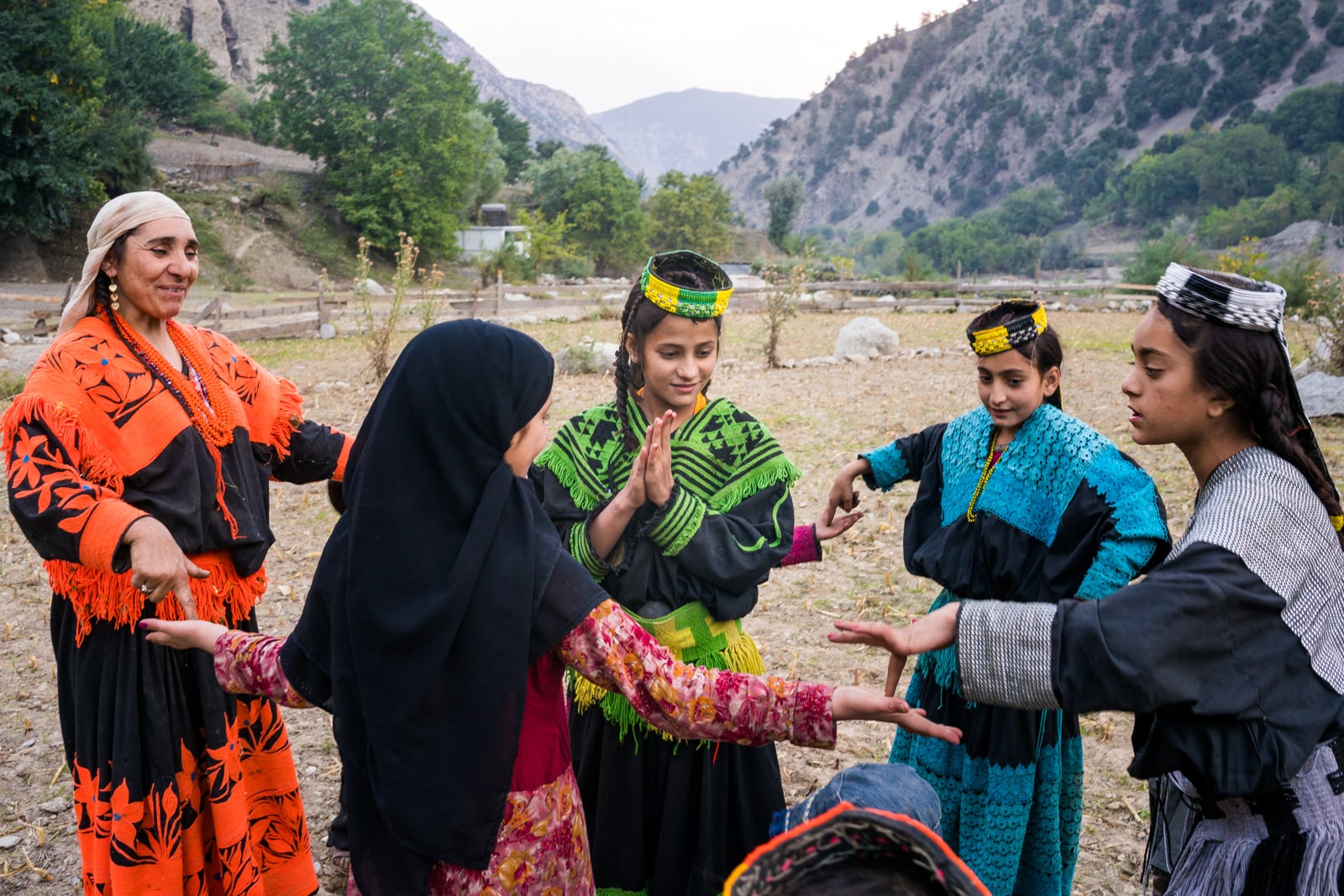
Playing games with some boisterous Kalasha girls
It used to be that your movements were restricted if visiting the Kalasha Valleys. Foreign travelers were assigned police escorts upon entering any of the valleys.
However, new tourism policies have been implemented, and you are now more free to wander around without an escort. You can hike around any of the valleys, visit small villages deeper in the valleys than previously accessible, or even hike from one valley to the other. Ask at your guesthouse or homestay for more information.,
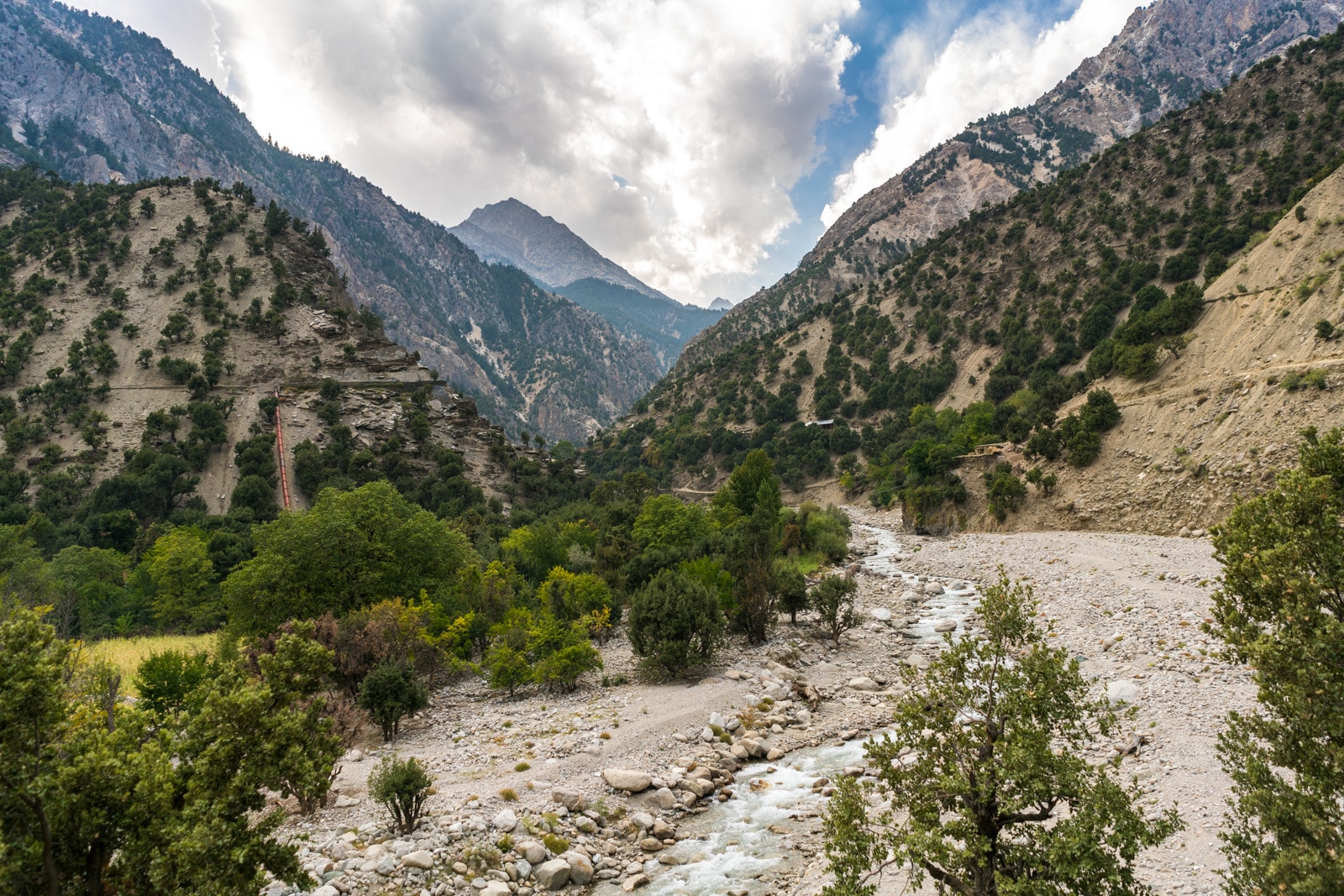
Wandering along the road through Rumboor
Mobile networks in the Kalasha Valleys
If you need to have phone signal or internet while in Kalash, make sure to get yourself a Telenor SIM card. It’s the only network provider operating in the Kalasha Valleys.
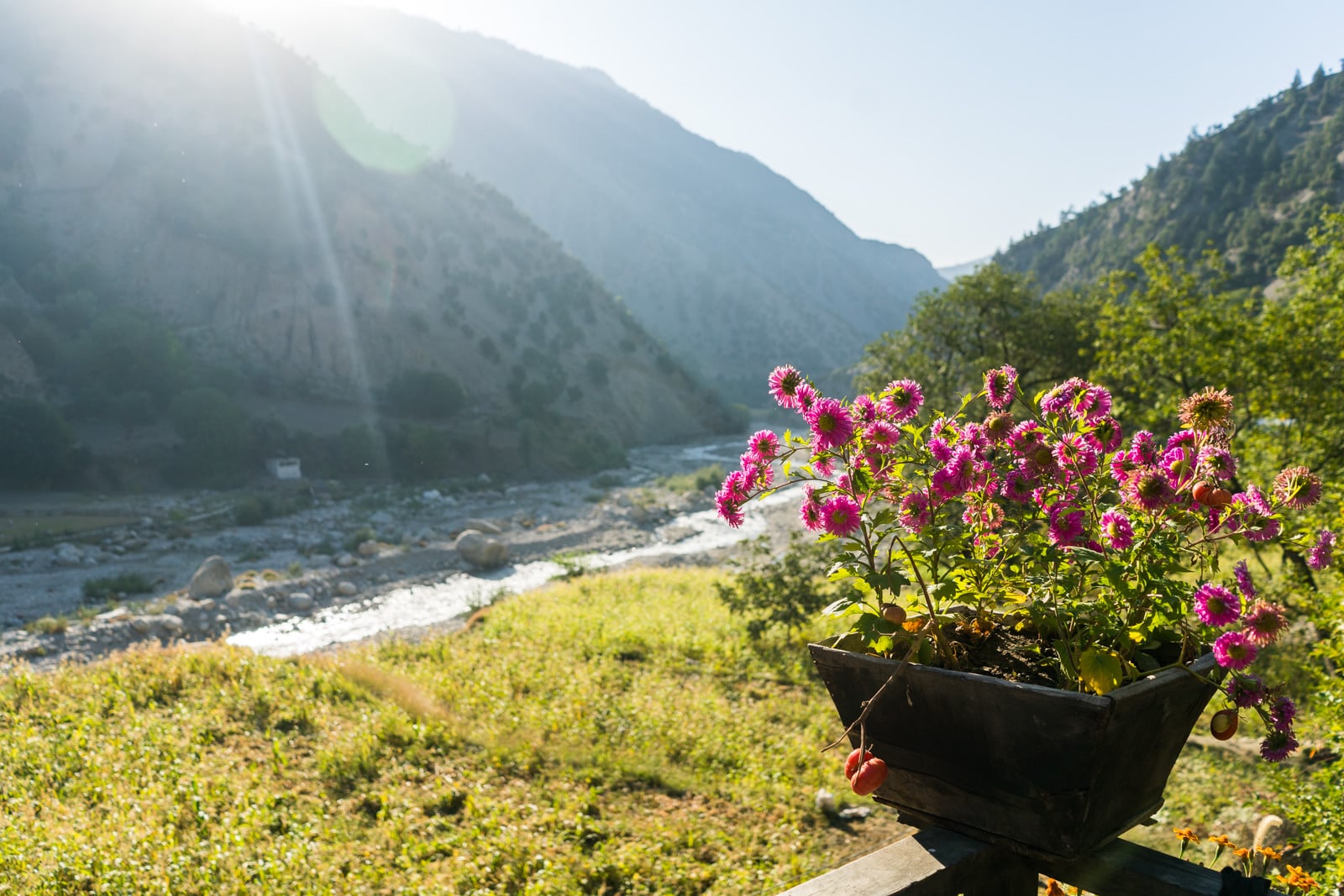
Can’t complain about the view from the porch of Kalash Home Guest House in Rumboor!
Where to stay in the Kalash Valley
Bumburet
This valley has several hotels and guest houses and is becoming less Kalash and more Muslim by the day. Luckily, there are still several Kalash-run guesthouses where you can get your dose of local culture. Kalash House is a basic but friendly guesthouse in Brun that also offers camping space, and there are two more Kalash-owned guesthouses nearby in case it’s full: Kalash Galaxy and Kalash View
Rumboor
Rumboor only has three guest houses, and the most homely of the lot is Kalash Home Guest House. If you’re driving into Rumboor, it will be on your left at the start of Grom village—you can’t miss it! Run by the amiable Engineer Khan, the food is delicious, the family is friendly, and the location great.
Rooms are 2000 – 3000 Rsper person, depending on the season. Food is usually included in the price, and you can buy homemade wine for 1,000 Rs per 1.5 liters if Engineer isn’t in the mood to drink with you.
If it’s full, you can try Kalash Indigenous Guesthouse, also in Rumboor.
Birir
More remote and with little in the way of facilities, I only know of Irfan Guesthouse in Guru village from the Pakistan Traveller Guidebook, the most comprehensive guidebook for Pakistan available.
Get a copy of the Pakistan Traveler Guidebook here for more information on traveling in the Kalash Valleys and other parts of Pakistan.
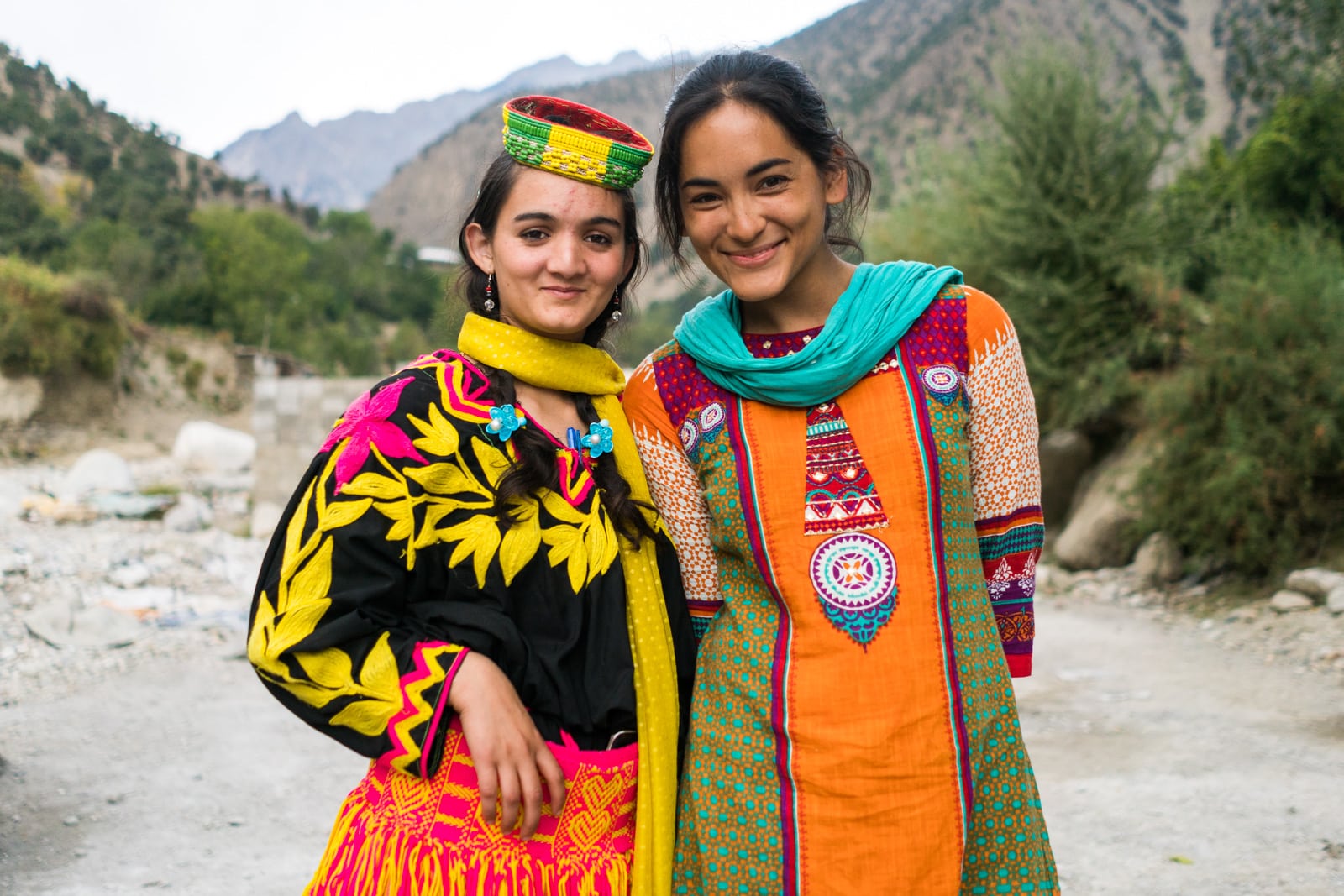
A colorful combination with one of the Kalasha girls I befriended
Responsible tourism in the Kalash Valley
The Kalasha Valleys are naturally and culturally beautiful, but beauty can easily be eroded by the onset of mass tourism. To do your part to preserve the beauty of the area, and ensure your tourism has a positive effect, please keep the following things in mind:
- Stay in a hotel/guesthouse run by a Kalasha person or family. Little of the tourism money that flows to the valleys end up in Kalasha pockets, so this is how you can ensure it does!
- Ask before taking photos. There’s no doubt that the Kalasha people, particularly the women, are stunning. However, many women are averse to being photographed (outside of festivals). I’ve also heard tensions are growing between the Kalash and outsiders, partially because of the way domestic tourists arrive and start snapping photos of women and children without asking or showing any kind of consideration. Instead of creeping on the women, befriend them, talk for a while, then ask for a photo.
- Enjoy the natural products, not packaged snacks. There are plenty of native fruits, vegetables, and nuts growing around the valleys. Snack on those, rather than contributing to the sorry state of plastic waste afflicting the valleys. And, of course, collect your trash, don’t throw it on the ground.
- Drink the local wine and tara responsibly. It’s poor form to show up as a guest in someone’s area, then get utterly shitfaced, loud, and destructive on their alcohol. If you can’t handle your drink, limit your consumption. It means more for those of us who can control ourselves.
Police registration for foreigners in Chitral and the Kalash Valley
You don’t have to register with the police in Chitral anymore. Foreigners are no longer assigned a guard when visiting the Kalash Valleys. When you travel to Chitral, you will register and get a FRO either at Lowari Tunnel or after Shandur Pass, depending on the route you take.
There are several police checkpoints on the way to the valley, and you might have to register when you arrive in the Kalash Valleys.
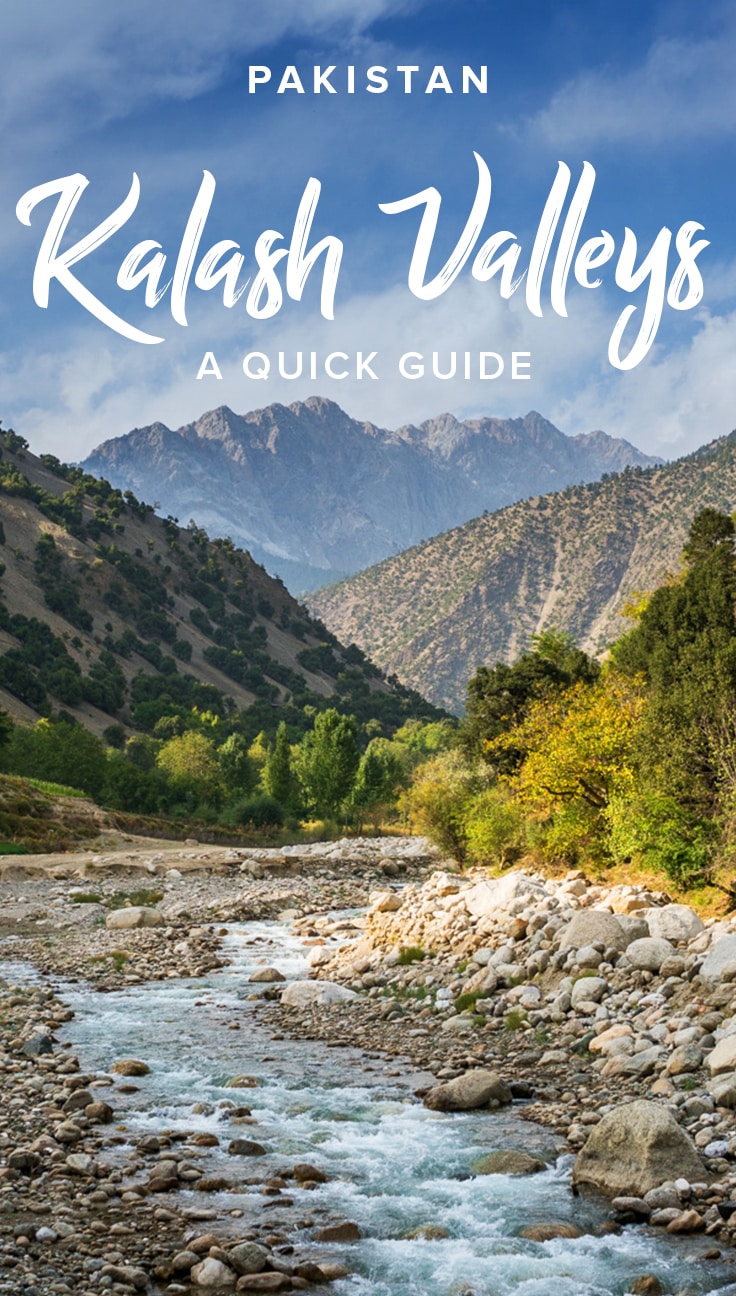
So there you have it, a complete guide to the Kalash Valleys with everything you need to know. Let me know in the comments if anything has changed.
No comments:
Post a Comment